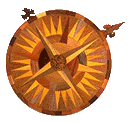 | Archaeology of |  |
 | Archaeology of |  |
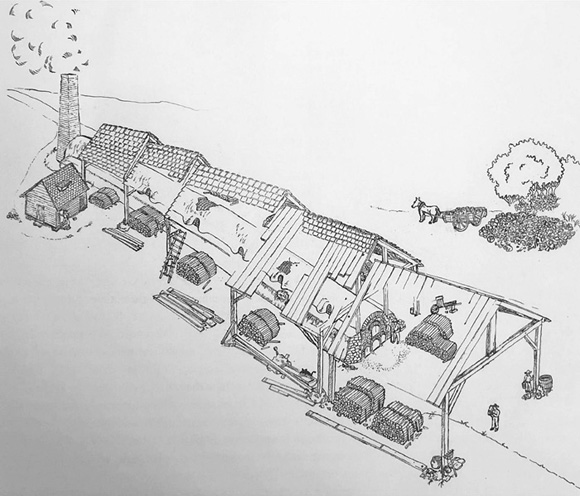 This is a conjectural reconstruction drawing of the Pottersville, SC kiln for producing stoneware, circa 1817. Drawing by Oliver Mueller-Heubach, courtesy of Robert Hunter and Oliver Mueller-Heubach. Oliver is an archaeologist with expertise in investigating stoneware kilns. He is also a gifted artist. Dr. Mueller-Heubach examined our excavation findings, reports, and publications. Based on this detailed body of data, he produced a reconstruction rendering of the kiln. You can learn more in an article with more of his renderings of the Pottersville kiln and support buildings: “Visualizing the Stoneware Potteries of William Rogers of Yorktown and Abner Landrum of Pottersville,” by Robert Hunter and Oliver Mueller-Heubach, in Ceramics in America (2019).
Reports of Project Results and New Questions, 2017Our project collaborators published a series of peer-reviewed articles on a variety of studies, findings, and new questions concerning the pottery communities of Edgefield in 2017. 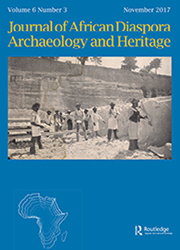
Who Were the Potters in the Old Edgefield District? by Carl Steen and Corbett Toussaint. J. of African Diaspora Archaeology & Heritage 6(2): 78–109 (2017) (link). Crosses, Crescents, Slashes, Stars: African American Potters and Edgefield District Pottery Marks, by J. W. Joseph. J. of African Diaspora Archaeology & Heritage 6(2): 110–132 (2017) (link). A Dragon Kiln in the Americas: European-American Innovation and African-American Industry, by George W. Calfas. J. of African Diaspora Archaeology & Heritage 6(2): 133–154 (2017) (link). Manufacturing Social Class: Entrepreneurs and Industrial Slavery in the Rural Antebellum South, by Brooke Kenline-Nyman. J. of African Diaspora Archaeology & Heritage 6(2): 155–169 (2017) (link). Journal of African Diaspora Archaeology and Heritage, Vol. 6, Issue 3 (Nov. 2017)
Jug Factories and Fictions: A Mixed Methods Analysis of African-American Stoneware Traditions in Antebellum South Carolina, by Jamie Arjona. J. of African Diaspora Archaeology & Heritage 6(3): 174-195 (2017) (link). Tides of Celadon: Glaze Color Chronology from the Edgefield Pottery District, South Carolina, by Tatiana Niculescu. J. of African Diaspora Archaeology & Heritage 6(3): 196-224 (2017) (link). The Social Landscape of Potteries: Refined Earthenwares at Pottersville, South Carolina, by Zev A. Cossin. J. of African Diaspora Archaeology & Heritage 6(3): 225-242 (2017) (link). The Expanding Legacy of the Enslaved Potter-Poet David Drake, by Arthur F. Goldberg and Deborah A. Goldberg. J. of African Diaspora Archaeology & Heritage 6(3): 243-261 (2017) (link). Historical Significance and Project BackgroundThe first innovation and development of alkaline-glazed stoneware pottery in America occurred in the Edgefield District of South Carolina in the early 1800s. It remains an enduring mystery as to how these new ceramic methods were developed in that place and time, and how the techniques of clay choice, temper, and glaze developed over the following century. These potteries employed enslaved and free African-American laborers in the 19th century, and the stoneware forms also show evidence of likely African cultural influence on stylistic designs. Edgefield potteries thus present fascinating research questions of understanding technological innovations and investigating the impacts of African cultural knowledge and racial ideologies on a craft specialization during the historic period in America. This project entails an interdisciplinary, collaborative, and archaeological study of the first development in America of alkaline-glazed stoneware pottery forms, the development of that South Carolina industry over time, and the impacts of racism and African cultural influences on those processes.
The technological innovation of alkaline-glazed stoneware pottery was introduced in North America by potteries operated by Abner and John Landrum in the Edgefield, South Carolina area in the first decades of the 19th century. These technological developments by entrepreneurs of Scots-Irish heritage played out in a landscape shaped by racial difference. Numerous African-American laborers, including "Dave the Potter" who added inscriptions to his vessels, worked at these production sites. Advertisements in local newspapers in the early decades of the 1800s listed enslaved laborers with skills in pottery production. African Americans most likely participated in all phases of the production process, such as: building and maintaining the kilns; digging and transporting clay; working and grinding raw clay in "pug" mills; chopping wood for fuel; preparing glaze mixtures, tempers, and clay pastes; turning the pottery wheels and shaping the vessels; and loading and unloading the kiln firings. 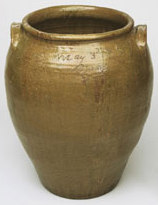 As local historians Holcombe and Holcombe (1989: 22) observed, the "District's ceramic entrepreneurs would never have been able to manufacture such large quantities of Edgefield wares without the slave participation." Indeed, in the period of 1800-1820, the recorded number of enslaved African Americans in the surrounding area had increased to comprise half of the Edgefield District's population. An illegal transport of enslaved laborers on the ship Wanderer delivered 170 newly-captive Africans to the Edgefield District in 1858. The production of remarkably shaped "face vessels" at local potteries have also been analyzed as presenting evidence of the influence of stylistic traditions from cultures of West Central Africa. 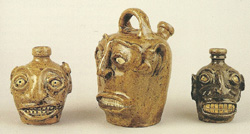 This project seeks to undertake detailed archaeological investigations of principal sites in Edgefield, conduct archival research, and start a multi-year community engagement and education program related to these subjects. Archaeological field schools and research teams at such pottery sites can explore both the production facility remains and the residential sectors for the enslaved and free African-American laborers. Primary research questions include: (1) examining the distribution of work areas and residential locations in each pottery site and analyze the degree of spatial segregation due to the impacts of slavery and racism; (2) understanding differential uses and development of those work and residential spaces, as reflected in archaeological features and artifact distributions, and the degree to which variations correlate with different racial categories associated with the occupants; (3) analyzing faunal and botanical remains to explore and contrast dietary and health patterns between residential sites and the degree to which variations correlate with different racial categories associated with the occupants; and (4) understanding the development and changes over time in the technologies of pottery production at these three manufacturing sites.
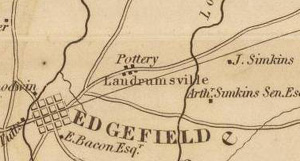 2011 Field School ResultsOur first six-week archaeological field school, from May 23 through July 1, 2011, focused on the site of Landrumsville, later called Pottersville, where Abner Landrum started the first stoneware production facility in the Edgefield district in the early 1800s. We excavated the kiln and related production areas and conducted surveys to locate the house sites of the craftspeople and laborers who created the Pottersville village surrounding that manufacturing facility. We also convened a speaker series on Edgefield history, archaeology, and ceramics traditions. Instructors included Prof. Fennell, U. Illinois doctoral student George Calfas, University of South Carolina graduate student Brooke Kenline, and archaeologist Carl Steen of Diachronic Research Foundation, among others. The instructors and students (shown below) stayed in local housing in the Edgefield area during this six week field school, and visited nearby archaeology sites and museums on weekend trips.
Our team extends sincere thanks and appreciation to Ms. Beth Cali and her family, owners of the Pottersville site, for their hospitality. This field school was also made possible by the generous support and guidance of Bettis Rainsford, Tricia Glenn, Steve Ferrell, Leonard Todd, Greg Allen, Jill Koverman, John Vlach, Maggi Morehouse, Jamie Koelker, and Justin Guy. We also greatly appreciate the terrific support of the Joanne T. Rainsford Discovery Center, the Historical Society of Edgefield, and the Edgefield Inn. Special thanks to Sean Taylor of the South Carolina Department of Natural Resources and to Joe Joseph, Christopher Espenshade, and Sarah Lowry of New South Associates for their volunteer help and expertise. Tim Scarlett of Michigan Technical University, an expert in the industral archaeology investigation of kiln sites, helped us in formulating our research plan for the Pottersville production site.
Based on historical and archaeological studies of other groundhog kilns from later periods in the U.S., we had anticipated that the Pottersville kiln would be no more than 30 to 40 feet in length and 9 to 12 feet in width. The Pottersvile kiln proved to be 105 feet in length and 12 feet in width, as shown in the image above. The parameters of the kiln (outlined above in red) were demonstrated by excavation units along all exterior boundaries and within the kiln interior. This was a kiln operation of remarkable scale, fired with prodigious quantities of wood. The last firing of ceramic vessels was uncovered in the strata of the kiln remains. Our team has worked to publish and communicate the results of these archaeological investigations as promptly as possible. Please see the articles already published in the South Carolina Antiquities and Historical Archaeology journals by Joe Joseph, Carl Steen, Brooke Kenline, and Nicole Isenbarger, among others, in the resource list provided below. The following is an excerpt from George Calfas' 2011 article in South Carolina Antiquities journal describing the field school excavations. While the kiln site at Pottersville has been known for decades, no one confidently knew which part of the hillside were kiln remains and which part was a waster pile. Without the assistance of geophysics, we began the project at the high point of the hill guided by stones just barely breaking through the topsoil. We felt that due to the elevation and prevailing winds this would be an ideal location for the kiln. We broke soil on the first afternoon of the field school and by the end of the day we realized that we were indeed on top of the kiln wall. The orientation of the wall was a bit different than we had expected -- something we learned to get used to with this project. Using this same "exposed" stone methodology we inserted additional units down the hill and quickly learned that we were dealing with something much larger than we had planned.
You can read the full results of George Calfas' research from 2009-2013, including all details of data collection and interpretation from the 2011 excavations at Pottersville, in his 2013 dissertation, entitled Nineteenth Century Stoneware Manufacturing at Pottersville, South Carolina: The Discovery of a Dragon Kiln and the Reinterpretation of a Southern Pottery Tradition, available here in pdf format (37 megabytes). Dr. Calfas received his doctoral degree from the University of Illinois in December 2013 based on this excellent work. Archaeologist Brooke Kenline's research at the Rev. John Landrum pottery site (38AK497) during the 2011 field school is reported in her 2012 Master of Arts degree thesis entitled Capitalist Entrepreneurs and Industrial Slavery in the Rural Antebellum South, available here in pdf format (18 megabytes). Her thesis abstract states: "While the alkaline glazed stoneware potteries of the Old Edgefield District of South Carolina have previously been categorized as a Southern 'folk tradition,' recent research regarding the extent of production and labor organization, along with the social and cultural milieu, reveal an early example of rural antebellum industrialization enabled and made successful through the use of enslaved labor. Archaeological investigations within the domestic loci at the Reverend John Landrum site (38AK497) combined with the analysis of historical documents help to illuminate the economic and social strategies of one pottery owner whose use of enslaved labor within his own manufacturing establishment allowed him to gain the capital necessary to portray his desired social and economic position within the community. Although this analysis illuminates the actions and motivations of the 'invisible hand' of slavery, further research reveals that the enslaved were not passive victims of structural oppression, but rather, were able to exercise cultural creativity and take action within their own small sites of power." 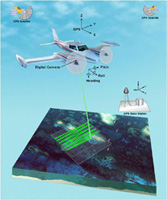 Our thanks to the South Carolina Humanities Council and National Endowment for the Humanities for grant support for two projects on Edgefield ceramics and archaeology. Congratulations to the Edgefield County Historical Society, as the sponsoring organization for these projects, and to George Calfas as Project Director and author of the grant proposals. The first project consisted of a five-part speaker series convened in Edgefield in the Summer of 2011, entitled "Pottersville: 200 Years of Pottery Production in the Edgefield District." The second project is entitled "Pottersville: Home of Alkaline Glazed Stoneware," and has the following description on the S.C. Humanities Council web site: "create a short documentary film of 8 to 10 minutes showcasing the alkaline-glazed stoneware tradition that is so important in Edgefield County. The film will be presented at the Joanne T. Rainsford Discovery Center in Edgefield, the McKissick Museum in Columbia, at regional historical society meetings, as well as on several websites, including SCETV's KnowItAll.org, which reaches K-12 classrooms across the state" (http://schumanities.org/home). This project produced a 15-minute documentary with the goal of sharing the rich history of the pottery communities of Edgefield, the accomplishments of African-American and European-American artisans in those industries, and to document the 2011 Archaeological Fieldschool at Pottersville. 2013 Archaeology Field School ResultsOur 2013 field school was convened from May 30 to June 27. This field school focused on investigations at the Pottersville site and the Rev. John Landrum site within the area of the Old Edgefield Pottery District, and provided training in the techniques of excavation, mapping, artifact classification and contextual interpretation. The University of Illinois field school at Pottersville was taught by graduate students Jamie Arjona and Tatiana Niculescu, working in collaboration with Prof. Chris Fennell. The archaeological investigations were also supervised by archaeologists Carl Steen (Diachronic Research Foundation), Sean Taylor (S.C. Dept. of Natural Resources), and Chris Judge (U. South Carolina). Students and volunteers worked in supervised teams, learning to function as members of a field crew, with skills necessary for becoming professional archaeologists. They received training in the techniques of excavation, mapping, artifact classification, and contextual interpretation. Laboratory processing and analysis was ongoing during the field season. Evening lectures by project staff, visiting archaeologists, and historians focused on providing background on how field data are used to answer archaeological and historical research questions. Lodging was provided at the beautiful Edgefield Inn. Mr. Bettis Rainsford, the owner of the Inn, has been incredibly supportive of our archaeology projects and provides rooms at a fraction of the usual rates for this elegant hotel. Students and volunteers at the Pottersville site conducted a systematic metal detecting survey, a ground penetrating radar survey, and excavations that targeted the most promising locations identified in those efforts. Patrick Severts and Josh Blackmon of New South Associates supervised the metal detecting survey and trained participants in those techniques. Chris Thornock, George Wingard, and their colleagues at the Savannah River Archaeological Research Program conducted the ground penetrating radar survey and educated our students and volunteers in those methods as well. Our field school participants at Pottersville excavated 16 shovel test pits and three one-meter square units to test the areas covered by the metal detecting survey. They also excavated numerous one-meter-square units to test the areas of the "pug mill" and "turning shed" at Pottersville. The ground penetrating radar survey identified the locations of those work areas in which clay was processed in a mill and vessels were shaped on turning wheels during the early 1800s. Excavations at Pottersville in 2011 revealed that the kiln consisted of a barrel vault design, 105 feet in length, representing an industrial-scale structure patterned after a Chinese "dragon" kiln. Excavations in 2013 revealed a pug mill for processing clay that was similarly of an industrial scale, far larger than pug mills uncovered at late 1800s sites that utilized smaller "groundhog" kilns. 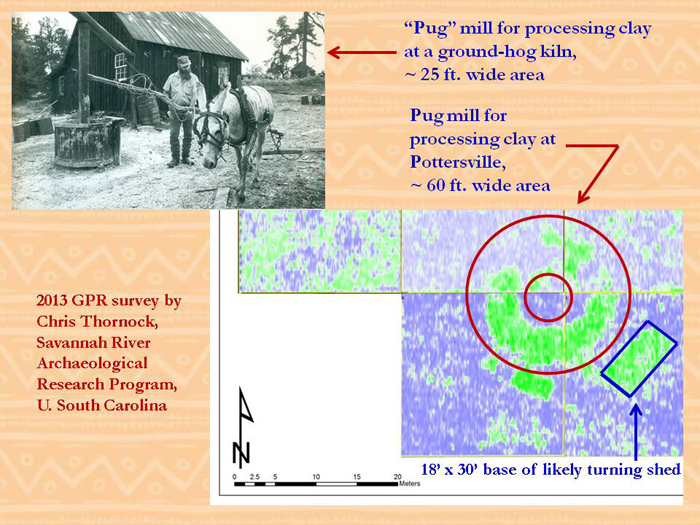 As field supervisors Jamie Arjona and Tatiana Niculescu summarize (2014: 80): Read more about our findings at the Pottersville site in Jamie and Tatiana's 2014 article, "Turning Clay into Craft: Field Notes from 2013 Excavations at Pottersville, SC." South Carolina Antiquities 46: 77-80 (pdf).The results of the UIUC 2013 field season indicate the striking immensity of Pottersville's ceramic production. While most historically documented pug mills depicted in photographs utilize a single work animal and a smaller diameter pathway, the Pottersville pug mill measures an astounding 16 m (just over 50 ft.) in diameter, with its track measuring approximately 5 m (roughly 16 ft.) in width. This size indicates the possible employment of more than one work animal. Furthermore, the presence of at least six other associated rectangular structures, including the 10 x 5 m turning shed, indicates a vast and complex production center. These structures each contributed a unique function to the broader kiln complex, within which enslaved laborers designed hundreds of thousands of ceramics that would eventually make their way into homes across the southeastern United States. At the Rev. John Landrum site, students and volunteers assisted Carl Steen and his colleagues in excavations at two domestic structures. One structure was occupied by Rev. Landrum after about the 1830s. We sampled the adjacent yard area, uncovered a segment of the cellar wall, and part of a cellar in a structure adjacent to the main house. The other structure was built in the early 19th century and was probably occupied by the Landrums until the later, more elaborate house was built. This continued to be used and was the home, presumably, of an enslaved family. This may have been the famed potter that signed his wares "Dave." There we uncovered a chimney base and explored a shallow cellar and a rich trash midden. You can read more about these findings in Carl Steen's 2014 article, "Archaeology at the Rev. John Landrum Site, 2011-2013." South Carolina Antiquities 46: 21-34. Our field school was accompanied by eight terrific events in our speaker series, entitled Cultural Creativity, History & Heritage in Edgefield. These public presentations and discussions focused on the cultural creativity, history, and heritage of the societies and pottery enterprises that flourished in the landscape of the Edgefield District of South Carolina. Looking also to broader contexts, we considered sites of natural and archaeological significance across South Carolina, including the prehistoric Topper site investigated by Dr. Al Goodyear and the many heritage sites under the stewardship of the South Carolina Department of Natural Resources. We explored the remarkable accomplishments of African Americans, European Americans, and Native Americans across time. Sponsored by the Edgefield County Historical Society and funded in part by The Humanities Council of South Carolina, a state program of the National Endowment for the Humanities. A full program is available online, with presentations by Maggi Morehouse, Vernon Burton, John Michael Vlach, Al Goodyear, Jason Young, George Wingard, Keith Stephenson, April L. Hynes, Mark M. Newell, and Sean G. Taylor.  2014 Archaeology Field ProjectNicole Isenbarger, principal of the Archaeological Research Collective, organized three weeks of excavations in October on the west side of the chimney area of the dragon kiln at the Pottersville site. A ground penetrating radar survey of that location by New South Associates in 2011 had identified potential structural remains. Nicole organized a local community initiative of volunteers to participate in this 2014 project, which was funded and sponsored by the University of Illinois. Dede Biles of the Aiken Standard newspaper reported on the project -- Archaeologist and Team Try to Solve Mystery in Edgefield Archaeology Field School, June 8 to July 12, 2016We returned for another season of field research on the amazing heritage and history of Edgefield pottery production. Our 2016 investigations focused on the areas of the turning shed and pug mill, which were located just downslope from the extraordinary "dragon" kiln built there circa 1815. 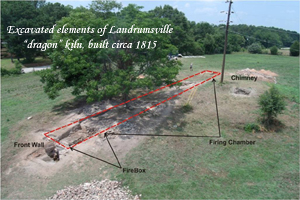 Students and volunteers worked in supervised teams, learning to uncover the archaeological record as members of an investigative team, with skills employed by professional archaeologists. You receive training in the techniques of surveying, interpreting geophysical and LiDAR data, excavations, mapping, artifact classification, and contextual interpretations. Laboratory processing and analysis was ongoing during the field season. Evening talks by project staff, visiting archaeologists, and historians focused on the history and heritage of Edgefield and how field data are used to answer archaeological and historical research questions. Lodging was provided at the beautiful Edgefield Inn. Mr. Bettis Rainsford, the owner of the Inn, has been incredibly supportive of our archaeology projects and provided rooms at a fraction of the usual rates for this elegant hotel. In addition to the archaeology project, the Edgefield County Historical Society, University of Illinois, and University of Chicago also hosted a related speaker series on the history and heritage of Edgefield, South Carolina, and the Southern stoneware pottery traditions, at the Joanne T. Rainsford Discovery Center in Edgefield. Speaker events in this series, entitled Cultural and Craft Legacies of Edgefield, included Bettis Rainsford, Joe W. Joseph, Carl Steen, George Wingard, Keith Stephenson, April L. Hynes, and members of the archaeology team. These events were held on June 9, 16, 23, 30, and July 7. Use this link to view the program of our terrific speaker series in 2016. Updates, Background Readings and Resources
|